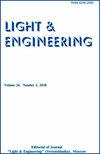动态分形激光图像对人体功能状态的影响
IF 0.3
4区 工程技术
Q4 ENGINEERING, ELECTRICAL & ELECTRONIC
引用次数: 0
摘要
本文的主题是预先设定分形参数的动态激光图像以视觉环境的形式形成的视觉刺激对人的影响。这种环境的结构和恢复性特征与那些以其恢复性特性而闻名的自然视觉环境相似:它降低了感觉系统的负荷水平,恢复了人类的功能(一般)状态等。这种模拟环境是利用采用非常规光学元件设计的激光光电RGB器件形成的,该器件将辐射源的光束结构转化为最适合感知的分形维数D = 1.3-1.5的抽象光场,这是评价该光场与自然视觉环境是否对应的积极标准。为了评估视觉模拟环境的影响程度,采用了基于人脑放松清醒状态相关的α节律活动分析的脑电图(EEG)方法。估计表明,所提出的视觉刺激作为一种光疗工具,具有有效的积极效果。在视觉刺激前后的18次推导中,α节律功率中位数的差异百分比数据表明,与基线水平相比,α节律功率增加了40%。最小生长量为17.8%,对应顶叶衍生P3-A1,最大生长量为51.4%,对应中颞衍生T4-A2。同时观察到收缩压和舒张压(BP)和心率(CR)分别有效降低8.5%和10%。所获得的数据表明,焦虑水平的降低,感官系统的卸载和动态激光图像对人体功能状态的积极动态影响。统计分析证实了α节律功率、BP和CR的正动态变化的有效性。本文章由计算机程序翻译,如有差异,请以英文原文为准。
The Impact of Dynamic Fractal Laser Images on Human Functional State
The subject matter of the article is the effect of a visual stimulation in the form of visual environment formed by dynamic laser images with preset fractality parameters on human. The structural and restorative characteristics of this environment are similar to those of the natural visual environment known for its restorative properties: it reduces the level of loading of sensory systems, recovers functional (general) state of humans, etc. Such analogue environment is formed using a laser optoelectronic RGB device designed with a non-conventional optical element, which transforms the structure of light beams from sources of radiation into an abstract light field with fractal dimensions of D = 1.3–1.5 optimal for perception, which is a positive criterion of evaluation of correspondence between this field and the natural visual environment. To estimate the level of the effect of the visual analogue environment, the electroencephalography (EEG) method was used which is based on analysis of activity of human brain α rhythm related to relaxed wakeful state.
The estimation demonstrated that the proposed visual stimulation causes a valid positive effect as a light therapy instrument. The obtained percentage data on the difference between median values of α rhythm power in 18 derivations before and after the visual stimulation has demonstrated increase of α rhythm power by 40 % as compared to the baseline level. Minimal growth was equal to 17.8 % which corresponds to parietal derivation P3-A1 whereas the maximum growth was 51.4 % and corresponded to the mid-temporal derivation T4-A2. Also valid reductions of systolic and diastolic blood pressure (BP) and cardiac rate (CR) by 8.5 % and 10 % respectively were observed. The obtained data are indicative of reduction of anxiety level, unloading of sensory systems and positive dynamics of the effect of dynamic laser images on human functional state. The statistical analysis confirms validity of the positive dynamics of α rhythm power, BP and CR changes.
求助全文
通过发布文献求助,成功后即可免费获取论文全文。
去求助
来源期刊

Light & Engineering
ENGINEERING, ELECTRICAL & ELECTRONIC-OPTICS
CiteScore
1.00
自引率
50.00%
发文量
0
审稿时长
1 months
期刊介绍:
Our magazine
develops comprehensive communication within the lighting community, providing opportunities for discussion and free expression of opinions of specialists of different profiles;
contributes to the convergence of science and engineering practice, the search for opportunities for the application of research results in lighting and technological applications of light;
keeps the scientific community up to date with the latest advances in the theory of the light field, providing readers with operational professional information;
initiates international cooperation, promotes and distributes the results of Russian authors in the international professional community;
provides equal opportunities for authors from different regions of Russia and other countries.
The journal publishes articles in the following areas:
visual and non-visual effects of radiation on humans;
light field theory;
photometry and colorimetry;
sources of light;
ballasts;
light devices, their design and production technology;
lighting and irradiation installation;
light signaling;
methods of mathematical modeling of light devices and installations;
problems of energy saving in lighting, installation and operation of lighting installations;
modern production technologies of lighting products for lighting control systems;
innovative design solutions;
innovations in lighting and lighting design;
the study of the effect on plants and animals, problems of using light in medicine;
problems of disinfection of premises, water and smell elimination with the help of technology of UV radiation using;
problems of light in the ocean and space.
 求助内容:
求助内容: 应助结果提醒方式:
应助结果提醒方式:


